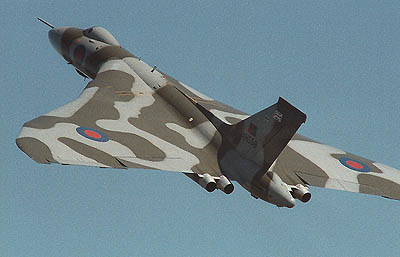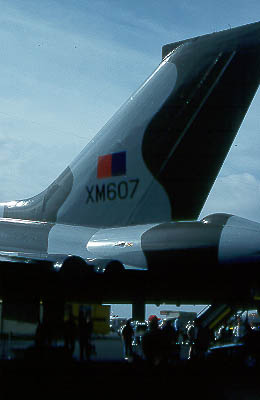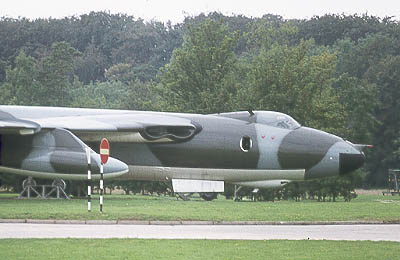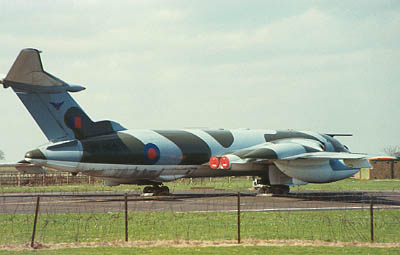| Waddington's
V-force nascent
 1959: Nearly forty years ago, half a lifetime for
most, but some things don't change. The airshow 'souvenir book' still features a foreword
by the Station Commander, plan of the parking arrangements and location of all the
toilets. But, one striking difference from today is the proliferation of advertisements
for cigarettes, the health of the nation not such a concern in those carefree
post-austerity times! Entry to the '59 show was 5 shillings per car, or 25p at today's
rates; assuming the cost doubles every ten years, that's still a very reasonable £3.
Participating were Vulcan B1s in the colours of 230 OCU and 83 Squadron, but the static
park was very thin by today's standards, comprising of a Vulcan, Victor, Valiant, Canberra, Vampire, Javelin, Varsity and Anson,
joined by two civilian Viking 'airliners' (surely an oxymoron?) providing pleasure flights
over the Lincolnshire countryside. Much where it is today, the static line was along the
taxiway fronting the hangars, while the main car park was on Alpha dispersal where today
the Sentries await each daily flight. For a full list of military
aircraft at the show click here. 1959: Nearly forty years ago, half a lifetime for
most, but some things don't change. The airshow 'souvenir book' still features a foreword
by the Station Commander, plan of the parking arrangements and location of all the
toilets. But, one striking difference from today is the proliferation of advertisements
for cigarettes, the health of the nation not such a concern in those carefree
post-austerity times! Entry to the '59 show was 5 shillings per car, or 25p at today's
rates; assuming the cost doubles every ten years, that's still a very reasonable £3.
Participating were Vulcan B1s in the colours of 230 OCU and 83 Squadron, but the static
park was very thin by today's standards, comprising of a Vulcan, Victor, Valiant, Canberra, Vampire, Javelin, Varsity and Anson,
joined by two civilian Viking 'airliners' (surely an oxymoron?) providing pleasure flights
over the Lincolnshire countryside. Much where it is today, the static line was along the
taxiway fronting the hangars, while the main car park was on Alpha dispersal where today
the Sentries await each daily flight. For a full list of military
aircraft at the show click here.
Although the souvenir book carries the
Victor on the cover, portraying the prototype WB771, the show is very much focussed on the
Vulcan, with the giant delta forming the backbone of the modern day Bomber Command. It
seems that all RAF Station Open Days carried the same souvenir book, with appropriate
'local' sections inserted at the front and back of the magazine, between which are general
air force articles. Such is the limited stock of photographs that one of a Vulcan is
printed twice within a couple of pages of each other!
It is obvious from the limited
specifications given in the souvenir book that the Vulcan was very much classified, even
such small details as aircraft serials being carefully avoided. The Waddington-related
sections are very much focussed on the training of crews for the mighty 'V' bomber, 230
OCU having been formed in 1955 at Waddington for the new aircraft, a vast leap from the
Lincolns and Lancasters in service at the time. Its first aeroplane, B1 XA897, was
received in July 1956 but this was merely a symbolic gesture as it almost immediately
returned to Boscombe Down, XA895 taking its place at Waddington a few months later. After  the
new jet had completed Service Trials the first crews started training the following
February, and from this initial course the first operational squadron, no. 83, was
created, 'A' Flight taking to the air on 21 May 1957 using aircraft borrowed from 230 OCU,
watched by the Duchess of Kent. It wasn't until July that 83 Squadron received its own
B1s, XA904 and XA905 carrying the unit's black antler badge just aft of the roundel.
Unfortunately for the original Waddington Vulcan XA897 and four of its crew, the aircraft
was lost at Heathrow in October 1956 when returning from a round-the-world trip. the
new jet had completed Service Trials the first crews started training the following
February, and from this initial course the first operational squadron, no. 83, was
created, 'A' Flight taking to the air on 21 May 1957 using aircraft borrowed from 230 OCU,
watched by the Duchess of Kent. It wasn't until July that 83 Squadron received its own
B1s, XA904 and XA905 carrying the unit's black antler badge just aft of the roundel.
Unfortunately for the original Waddington Vulcan XA897 and four of its crew, the aircraft
was lost at Heathrow in October 1956 when returning from a round-the-world trip.
Although officially a conversion unit,
230 OCU broke many records in those early years. Boston (USA) to Waddington was achieved
in 5 hours and 17 minutes and Waddington to Cyprus in 3 hours and 41 minutes, not
remarkable today but in the late fifties fighters were the only aircraft capable of
producing the necessary speed, but without the required range. These long range trips were
taken with propaganda in mind, the Deterrent being discreetly advertised to the rest of
the world. 83 Squadron was an exponent of this global power, carrying out flights to
Buenos Aires (ironic, given events in 1982!), Nairobi, Rhodesia, Florida, Vancouver, the
Middle and Far East, the Arctic Circle and the Philippines. Nearly every time the aircraft
operated without ground crews or special facilities, carrying the few spares needed
themselves.
By 1959, three squadrons had reformed on
Avro's finest, 83 Squadron at Waddington, 101 Squadron at Finningley and 617 Squadron back
at its 'proper' home at Scampton.
 Initially, Vulcan pilots were a special breed. Captains were required to be
'above average' and have at least 1,750 flying hours, while co-pilots needed at least 700
hours. Pay for a Captain was a heady £1,700 pounds a year; extrapolating this the same
way as before, it equates to £27,000 p.a., much as today. Navigators and Air
Electronics Officers needed to be experienced, although much of the equipment was taken
from earlier designs, such as the H2S radar. But, mere qualifications were not enough;
crews were selected for their personal qualities as well. The cramped confines of the
cockpit were a test in themselves, the performance of the aircraft putting greater strains
on the body than had been previously experienced in such a large bomber. V-force crews
were graded into four categories, the first being Unclassified on first joining the
squadron, then progressing through Combat, Select and Select Star by when they would be
considered an elite group. A test of their proficiency was to undertake a 'Lone Ranger'
flight to Cyprus or Africa, or a 'Western Ranger' to the States. Initially, Vulcan pilots were a special breed. Captains were required to be
'above average' and have at least 1,750 flying hours, while co-pilots needed at least 700
hours. Pay for a Captain was a heady £1,700 pounds a year; extrapolating this the same
way as before, it equates to £27,000 p.a., much as today. Navigators and Air
Electronics Officers needed to be experienced, although much of the equipment was taken
from earlier designs, such as the H2S radar. But, mere qualifications were not enough;
crews were selected for their personal qualities as well. The cramped confines of the
cockpit were a test in themselves, the performance of the aircraft putting greater strains
on the body than had been previously experienced in such a large bomber. V-force crews
were graded into four categories, the first being Unclassified on first joining the
squadron, then progressing through Combat, Select and Select Star by when they would be
considered an elite group. A test of their proficiency was to undertake a 'Lone Ranger'
flight to Cyprus or Africa, or a 'Western Ranger' to the States.
The OCU course started with several weeks
of ground study on theory and operation and included many hours in flight simulators,
albeit somewhat cruder examples of what is available today. An exact copy of the Vulcan
cabin, the simulator reproduced all conditions of flight (excepting 'g' loading) but
without any visual references. Flying the real thing was saved for the latter part of the
course, the crews learning to 'achieve maximum efficiency under operational conditions'. A
typical training sortie would involve a four hour flight cross-country, involving
simulated radar bombing runs against selected targets. Before the sortie at the briefing
the co-pilot would calculate fuel, endurance, aircraft weights, the air electronics
officer would check callsigns and classified codes while the two navigators would be kept
very busy, the nav radar assembling information on the allocated targets and the nav
plotter collating route information and weather details. Once in the aircraft a lengthy
checklist was run through, often taking up to an hour before the engines were started.
 Exercises
were part of everyday V-force life, dispersal airfields providing plenty of opportunity to
operate from alternative locations across the country. In the late '50s, thirty-six
airfields were available to the V-bombers, including
familiar names such as Lossiemouth, Kinloss, Leuchars, Prestwick, Aldergrove, Leeming,
Cranwell, Shawbury, Valley, Lyneham, Boscombe Down, Manston and St. Mawgan together with
less well known locations such as Machrihanish, Middleton St. George, Elvington,
Burtonwood, Llanbedr, Brawdy, Bedford, Pershore, Kemble, Filton and Tarrant Rushton. Bags
were always kept packed in readiness for a 'Mickey Finn', the codeword for an immediate
dispersal exercise. John Nickolls, a technician working on Vulcans in the late sixties,
explains what was involved; "A "Mickey Finn" and it's cousin
"Mick" were rumoured about for days in advance, just as a real bout of military
action would be. "Mick", which I experienced once, was a station wide alert
where everyone stood to (usually at 4 in the morning) and concentrated on getting all
aircraft serviceable and armed as soon as possible. It lasted about two days, and
culminated in an engine run by all aircraft. Twenty-six Vulcans - very impressive! A
"Mickey Finn" was similar, but the aircraft were actually dispersed, and
personnel too, and lasted longer. Luckily I never had one of those. The almost daily
practice alerts were "Exercise Edam", and were often sounded at lunchtime, when
the ground crews were in the mess getting their dinner. Trays and plates all over the
place!" Exercises
were part of everyday V-force life, dispersal airfields providing plenty of opportunity to
operate from alternative locations across the country. In the late '50s, thirty-six
airfields were available to the V-bombers, including
familiar names such as Lossiemouth, Kinloss, Leuchars, Prestwick, Aldergrove, Leeming,
Cranwell, Shawbury, Valley, Lyneham, Boscombe Down, Manston and St. Mawgan together with
less well known locations such as Machrihanish, Middleton St. George, Elvington,
Burtonwood, Llanbedr, Brawdy, Bedford, Pershore, Kemble, Filton and Tarrant Rushton. Bags
were always kept packed in readiness for a 'Mickey Finn', the codeword for an immediate
dispersal exercise. John Nickolls, a technician working on Vulcans in the late sixties,
explains what was involved; "A "Mickey Finn" and it's cousin
"Mick" were rumoured about for days in advance, just as a real bout of military
action would be. "Mick", which I experienced once, was a station wide alert
where everyone stood to (usually at 4 in the morning) and concentrated on getting all
aircraft serviceable and armed as soon as possible. It lasted about two days, and
culminated in an engine run by all aircraft. Twenty-six Vulcans - very impressive! A
"Mickey Finn" was similar, but the aircraft were actually dispersed, and
personnel too, and lasted longer. Luckily I never had one of those. The almost daily
practice alerts were "Exercise Edam", and were often sounded at lunchtime, when
the ground crews were in the mess getting their dinner. Trays and plates all over the
place!"
 Ground crews would prepare the aircraft, including starting engines, while the
flying crews were briefed, after which they would take charge of their 'combat ready'
jets. With engines off the crew would await further instructions from HQ Bomber Command at
High Wycombe over the 'Bomber box', the telex linking all V-bomber stations. Once given
the signal, engines would be started within two minutes and the bombers scrambled in fours
to the designated dispersal airfield. At the dispersed site the flying and ground crews
would live in caravans next to the aircraft, awaiting the 'scramble' tannoy much as did
the fighter pilots in the Battle of Britain. If the signal came, they would quickly don
flying suits and race to the aircraft, the Air Electronics Officer being the first to
enter followed by the two pilots and two navigators. Cockpit checks will have been carried
out every 24 hours by the ground crew so the first action would be to start the engines
while strapping themselves into the seats. Within the two minutes the aircraft would roll
and head straight for the runway, not waiting for clearance from the tower. Nuclear
training sorties would involve using the blackout blinds in the cockpit, although the
weapons were rarely carried in peacetime. Before 'Blue Steel' became the standard weapon
of the sixties, the bomb carried by the Vulcan B1 was the 'Blue Danube', being some
10,000lbs in weight. Ground crews would prepare the aircraft, including starting engines, while the
flying crews were briefed, after which they would take charge of their 'combat ready'
jets. With engines off the crew would await further instructions from HQ Bomber Command at
High Wycombe over the 'Bomber box', the telex linking all V-bomber stations. Once given
the signal, engines would be started within two minutes and the bombers scrambled in fours
to the designated dispersal airfield. At the dispersed site the flying and ground crews
would live in caravans next to the aircraft, awaiting the 'scramble' tannoy much as did
the fighter pilots in the Battle of Britain. If the signal came, they would quickly don
flying suits and race to the aircraft, the Air Electronics Officer being the first to
enter followed by the two pilots and two navigators. Cockpit checks will have been carried
out every 24 hours by the ground crew so the first action would be to start the engines
while strapping themselves into the seats. Within the two minutes the aircraft would roll
and head straight for the runway, not waiting for clearance from the tower. Nuclear
training sorties would involve using the blackout blinds in the cockpit, although the
weapons were rarely carried in peacetime. Before 'Blue Steel' became the standard weapon
of the sixties, the bomb carried by the Vulcan B1 was the 'Blue Danube', being some
10,000lbs in weight.
1960 would see the reforming of 44
Squadron at Waddington, back at the base from where the unit operated the first Lancasters
some eighteen years earlier. 230 OCU was up to unusual tricks again, this time two Vulcans
flew from Heathrow to Montreal in just five hours bearing telerecordings of Princess
Margaret's wedding for immediate transmission over the Canadian and American television
networks; the birth of the satellite would prove such feats useless in years to come!
Conversion to the B2 started in July for 230 OCU with the arrival of the first airframe;
this was no less than XH558, the much-loved airshow performer
of the late eighties and early nineties which would prove to be the last flying Vulcan,
serving out her time at Waddington alongside the incoming Sentry AEW1s. Back to 1960, the
'At-Home' open day featured participation from the USAF in the form of a B66, F100 and F101 while the souvenir
book would feature that same Vulcan picture yet again, and also a word-for-word repeat of
welcome from the Station Commander! Make a note of the 1998
welcoming statement, and just check next year's when you go...
|